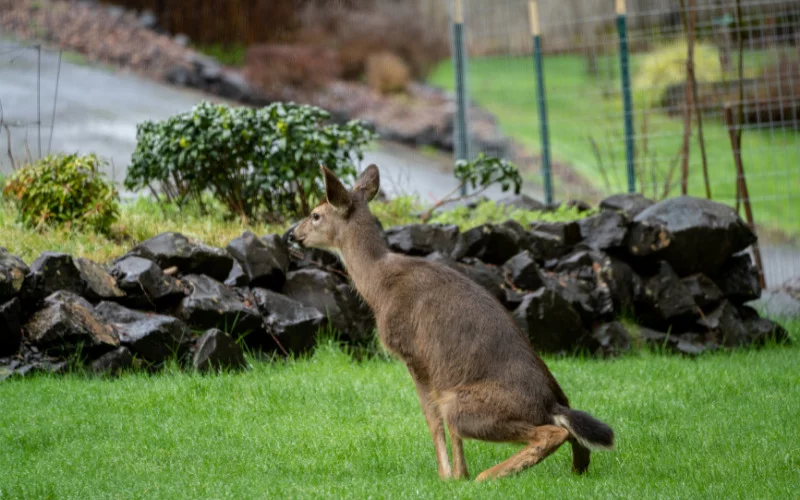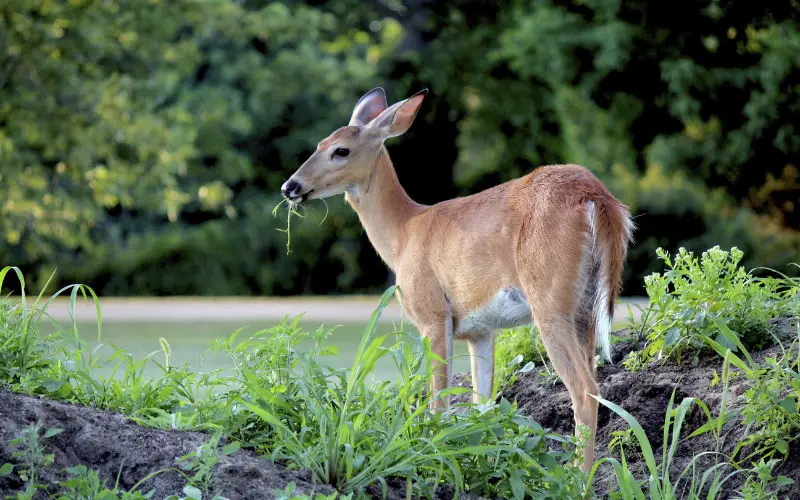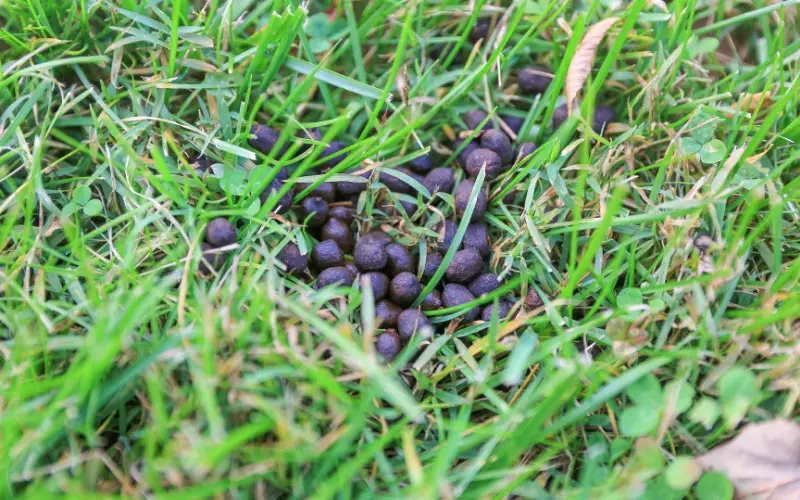Deer are majestic creatures that often pop up in your yard. Watching a deer move around in your yard gives you a magical feeling, one that makes you feel like a character in a Disney movie.
While watching a deer walk around your house may be enchanting, they tend to leave waste behind and eat up some of your plants.
If you ever find yourself in a position where you are questioning what to do with a deer pool in your yard, this article is for you.
Why Is There Deer Poop in My Yard?

Deers have a strong sense of smell and will get attracted to plants and vegetables in your garden. If your area is not well-fenced, deers could get in.
When deers infiltrate your yard, they go on with their meal which can cause damage to your plants if they are not stopped.
After a successful meal, they pass waste on your yard, which is never pleasant for any homeowner.
Related Article: What To Do With Backyard Dog Poop
Is Deer Poop Bad for Your Lawn?
Your love-hate relationship with deer will lead you to question whether a deer poop is bad for your lawn or whether it’s just like any regular poop that can serve as compost.
Deer poop contains a high amount of nitrogen like compost do, they can be used as natural fertilizers to grow your grass, but since a deer won’t care if the poop is distributed around the lawn evenly or not, it becomes a bad thing. The piled-up poop begins to burn your grass because of its high nitrogen content.
Is Deer Poop Harmful to Humans?

A deer could be a carrier of bacteria and diseases; hence it should be avoided. Children, the elderly, and individuals with a compromised immune system should not be near a deer’s poop as there is a risk of getting infected.
Another way deers can pass on bacteria is by ingesting food nurtured with deer poop as a fertilizer.
Ingestion poses a greater risk of getting. Hence food crops associated with deer poop should be properly managed.
Some of the diseases from a deer may be communicable and can be transferred from one person to another, another reason why deer poop should be avoided.
An example of a disease transmitted from deer to humans is E. Coli and chronic wasting disease.
When you touch contaminated deer scat and put your fingers in your mouth, these diseases can be transmitted. Eating food crops without adequate cleansing can also lead to the transmission of this disease.
What Does Deer Poop Looks Like?
Deer feces are pellet-shaped and may look like a capsule; they are often mixed up with rabbit droppings, but rabbit droppings are larger, and the difference can be seen when closely inspected.
The pellet-shaped dung can be clumped together; how a deer poop appears is dependent on their diet.
If a deer feeds on twigs and leaves, their poop comes out separately, while a deer poop comes out clumped if it feeds on grasses, clovers, and alfalfas.
They are more than an inch in size, their color changes based on what they eat, it ranges from green to black to brown, green poop indicated ingestion of grasses or leaves, or it may mean that bile wasn’t fully broken down, brown and black poop color may be a result of dead red blood cells.
Deer dropping can be an indication that they are close by their feeding spot. The nearness of a deer to your yard is best indicated by how fresh a deer poop is; fresh poop is usually warm, but it will dry up with time. According to research, a deer defecates thirteen times a day, producing 93 pellets in around.
It was also discovered that a deer produces more clumped dung during spring and fall than separate ones.
It is important to differentiate a deer poop from the poop of other animals as it will help you be sure of the animal present in your yard.
Recommended: How to Fix a Muddy Backyard Dog Trail (3 Proven Solutions)
What To Do with Deer Poop in The Yard?

If you come across deer poop in your yard, the best option is to discard it. This can be done by using a shovel to pack it up and throwing it in a garbage can or somewhere far away from your home.
Deer poop can also be used as manure for growing plants; its high nitrogen contents have proved useful when it comes to fertilization.
When using deer poop as fertilizer, you should put it through a hot composting process to get rid of bacteria. This process works by mixing nitrogen, carbon, air, and water under favorable conditions to generate heat.
When your deer poop is at 140 degrees Fahrenheit for at least five days and has decayed for at least 40 days, it should be free of bacteria.
Be sure to wear gloves as a safety precaution and keep fresh manure different from fully composted manure.
You should also harvest crops that do not touch the soil 90 days after applying deer manure. You should harvest crops that touched the soil 120 days after applying manure; the National Organic Program recommended this tip.
Conclusion: What to Do with Deer Poop in the Yard?
A deer in a yard has proven to be a blessing and a curse for homeowners; you become clueless about what to do with this dung in your yard and whether it is safe to keep around.
It is not safe to leave deer poop in your yard, as it is harmful to your lawn, pets, and yourself.
Deer poop is not the best fertilizer for your fruits and vegetables as it can be contaminated with a bacteria known as E. coli which is harmful to whoever comes in contact with it.
To safely use deer scat as fertilizer, it must be composted under intense heat. If you don’t intend to use a deer poop, discard it quickly.
You May Also Like:
- Can I Shoot a Possum in My Backyard
- How Far Can Raccoons Jump
- What Sorts of Food Does Backyard Lizard Eat?
- Can You Eat Squirrel From Your Backyard
- Do Skunks Climb Trees or Fences?
- Can Possums Climb a Wall or Fence?
We trust this article helped you know What to Do with Deer Poop in the Yard. You may also want to check out What To Do With Backyard Dog Poop
Thanks for taking the time to read our article, and we hope you find it helpful. Would you mind leaving a comment below if you have any suggestions?
Kindly reach out to people by sharing this post on social media.
If you liked this article, then please follow us on Facebook, Instagram, and Pinterest.
